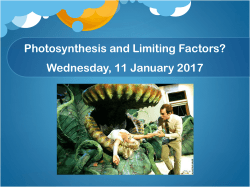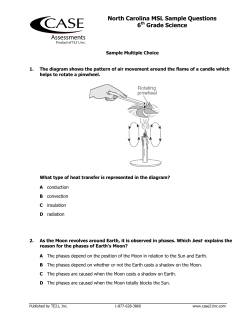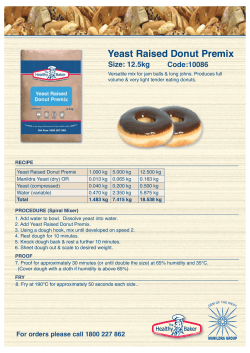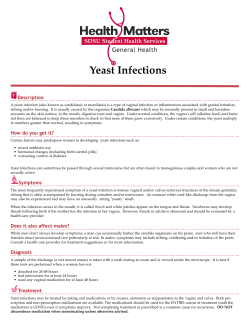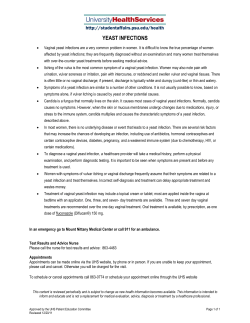
BIOLOGY – HIGHER LEVEL SAMPLE Coimisiún na Scrúduithe Stáit
M44 Write your Examination Number here Coimisiún na Scrúduithe Stáit State Examinations Commission LEAVING CERTIFICATE EXAMINATION BIOLOGY – HIGHER LEVEL SAMPLE 3 hours Section A Answer any five questions from this section. Each question carries 20 marks. Write your answers in the spaces provided on the examination paper. Section B Answer any two questions from this section. Each question carries 30 marks. Write your answers in the spaces provided on the examination paper. Section C Answer any four questions from this section. Each question carries 60 marks. Write your answers in your answer book. You should spend not more than 30 minutes on Section A and 30 minutes on Section B, leaving 120 minutes for Section C You must return your examination paper with your answer book at the end of the examination. Page 1 of 13 Blank Page Page 2 of 13 Section A Answer any five questions Write your answers in the spaces provided 1. Answer any five of the following. (a) State a function of the cell membrane ………………………………………………………… (b) State one feature that would allow you to identify an eukaryotic cell …………………………………………………………………………………….…………… (c) Name a human cell that is haploid ……………………………………………………………. (d) What term is used to describe a cellular reaction in which large molecules are broken down to smaller ones? ……………………………………………………………………………….. (e) What term is used to describe an individual’s genetic make up? …………………………….. (f) Name a scientist responsible for the Theory of Natural Selection …………………………………………….…………………………………………………… 2. Select the correct term from the following list to match each of the terms in column A and write it in column B. protein, enzyme, uracil, sap, ethanol, mutation, thymine, chlorophyll. A B DNA Ribosome Vacuole Fermentation RNA Active Site Variation Page 3 of 13 OVER→ 3. The diagram shows a section of human tissue containing an artery and a vein. [BIOPHOTO ASSOCIATES/SCIENCE PHOTO LIBRARY LTD.] Identify the artery by writing A on it and the vein by writing B on it. State two features of the artery that can be seen in the diagram which allowed you to identify it. 1 ………………………………………………………………………………………………… 2 ………………………………………………………………………………………………… Name two tissues that are present in the walls of arteries and veins and give a function of each of these tissues. Tissue ………………………….….. Function ………………………………….. Tissue ………….………………….. Function ………………………………….. Veins contain valves whereas arteries do not. What is the function of the valves? …………..…….…………………………………………………………………………………… 4. Answer the following in relation to the scientific method. What is an hypothesis? ………………………..………………… ………………………….. .….……………………………..………………………………………………………………….. What might an hypothesis develop into? …………………………………………………….. Why is a control important in an experiment? ……………………………………………. …………………………………………………………………………………………………….. Give an example of a control in a named experiment. ………………………………………….. …………………………………………………………………………………………………….. State two ways in which the results of an experiment may be presented. 1 ………………………………………………………………………………………………. 2 ………………………………………………………………………………………………. Page 4 of 13 5. (a) A 2.5 hectare field was surveyed for clover plants using the quadrat method. A quadrat of side 0.5 m was used. The results of the survey are shown in the table below. Quadrat Number 1 2 3 4 5 6 7 8 9 10 Number of Plants 6 2 2 2 4 0 2 5 5 2 Estimate the number of clover plants in the field. (1 hectare = 10 000 m2) ………………………………………………………………………………………………… ………………………………………………………………………………………………… ………………………………………………………………………………………………… ………………………………………………………………………………………………… ………………………………………………………………………………………………… …………………………………………………………………………………………………. (b) A survey of field mice was carried out in the field mentioned in (a) using the capture/recapture method. The field mice were caught using small mammal traps which were set at random points in the field. Forty field mice were captured, tagged and released at their capture points. One month later the traps were again set at the same locations and forty field mice were caught. Five of these were found to be tagged. Estimate the population density of the field mice in numbers per hectare. …………………………………………………………………………………………………. …………………………………………………………………………………………………. …………………………………………………………………………………………………. …………………………………………………………………………………………………. …………………………………………………………………………………………………. …………………………………………………………………………………………………. …………………………………………………………………………………………………. …………………………………………………………………………………………………. Page 5 of 13 OVER→ 6. The graph shows the variations in human body temperature over a number of days. 37.6 X 37.4 37.2 temperature mouth temperature 37 36.8 36.6 36.4 36.2 36 35.8 35.6 0 12 24 36 48 60 72 hours What was the minimum temperature recorded? …………………………..………………………. What was the maximum temperature recorded? …………………………………………………… Suggest a reason for the difference between body temperature during period X and the same period on the previous days. …………………………………………………………………………………. ………………………………………………………………………………………………………… What is the source of the heat that keeps the body at a fairly constant temperature? ………………………………………………………………………………………………………… State two responses that result when body temperature begins to drop. 1. ………………………………………………………………………………………………. ………………………………………………………………………………………………. 2. ………………………………………………………………………………………………. ………………………………………………………………………………………………. Explain briefly how sweating assists in the shedding of excess heat. ……………………………….. ……….………………………………………………………………………………………………… ……….………………………………………………………………………………………………… ……….…………………………………………………………………………………………………. ……….…………………………………………………………………………………………………. Page 6 of 13 Section B Answer any two questions Write your answers in the spaces provided Part (a) carries 6 marks and part (b) carries 24 marks in each question in this section. 7. (a) To which group of molecules do enzymes belong?…………………………………………… What is a denatured enzyme? (b) ……………………………………………………………… Answer the following by reference to an experiment that you carried out to investigate the effect of pH on the rate of enzyme action. Name the enzyme and substrate that you used. ………………………………………………………………………………………………… Draw a labelled diagram of the apparatus that you used. Explain how you varied the pH. ……………………………………………………………… ………..……………………………………………………………………………………….. State one factor that you kept constant in this experiment. ………………………………….. ……….………………………………………………………………………………………… How did you ensure that this factor was kept constant? ……………………………………… ……….………………………………………………………………………………………… Label the axes and draw a graph of the results that you obtained. Page 7 of 13 OVER→ 8. (a) To which kingdom do yeasts belong? ………………………………………………………… State one way in which yeast is beneficial to humans. ………………………………………. (b) Answer the following by reference to an experiment that you have carried out to investigate the growth of leaf yeast. Name the nutrient medium on which you grew the yeast…………………………………….. Why was a nutrient medium necessary? …………………………………….……………….. ……………..………………………………………………………………………………….. From what plant did you obtain the yeast. …………………………………………….. Describe how you transferred the yeast to the nutrient medium …………………………………………………………………………………….…………… …………………………………………………………………………………………………. …………………………………………………………………………………………………. …………………………………………………………………………………………………. Outline the procedures that you followed after you transferred the yeast to the nutrient medium. …………………………………………………………………………………………………. …………………………………………………………………………………………………. …………………………………………………………………………………………………. …………………………………………………………………………………………………. …………………………………………………………………………………………………. …………………………………………………………………………………………………. …………………………………………………………………………………………………. ……………………………………………………………………………………………….… ………………………………………………………………….……………………………… ……………………………………………………………………………………………….… ………………………………………………………………………………………………… …………………………………………………………………………………………………. ………………………………………………………………………………………………… ………………………………………………………………………………………………… ………………………………………………………………….……………………………… Page 8 of 13 9. (a) State a location in a flowering plant where a growth regulator is secreted …………………………………………………………………………………………………. Give an example of the use of a synthetic growth regulator. …………………………………………………………………………………………………. (b) The diagram shows apparatus that may be used to investigate the effect of the growth regulator IAA. Name A. ……………………………………………………………………………….. What is the purpose of A in this experiment? …………………………………………….. …………………………………………………………………………………………………. How would you make up solutions of different concentrations from a stock solution of IAA? ………………………………………………………………………………………………… ………………………………………………………………………………………………… …………….…………………………………………………………………………………… …………….…………………………………………………………………………………… …………….…………………………………………………………………………………… …………….…………………………………………………………………………………… …………………………………………………………………………………………………. …………….…………………………………………………………………………………… After preparation the dishes are placed standing on their edges for a number of days. What is the reason for this? ………………………………………………………………………. ……………..………………………………………………………………………………….. Describe the results that you would expect in this experiment. …………………………… …………………………………………………………………………………………………. ……………..………………………………………………………………………….. Page 9 of 13 OVER→ Section C Answer any four questions Write your answers in your answer book. 10. . 11. (a) (i) (ii) (iii) The same elements are found in carbohydrates and fats. Name these elements. State one way in which carbohydrates differ from fats. How do phospholipids differ from other lipids? (9) (b) Carbohydrates are classified as monosaccharides, disaccharides and polysaccharides. (i) Name a monosaccharide and state a role for it in living organisms. (ii) What is a disaccharide? (iii) Cellulose is a polysaccharide. What is it formed from? State a role for cellulose in living organisms. (iv) Name a polysaccharide that has a different role to cellulose. What is the role of the polysaccharide that you have named? (v) Describe a test for a named polysaccharide. (27) (c) Answer the following in relation to a test for 1. a reducing sugar 2. a protein. (i) (ii) (iii) (iv) Name the reagent(s) used. State the initial colour of the reagent. State whether the test requires heat. What colour indicates a positive result? (a) (i) (ii) What is meant by the term segregation as used in genetics? State the products of segregation when an organism is heterozygous in respect of the dominant allele A. (9) (b) (i) (ii) State the Law of Independent Assortment. In cattle the allele for red coat (R) is dominant to the allele for black coat (r) and the allele for straight coat (S) is dominant to the allele for curly coat (s). When a bull with a red, straight coat was mated with cows with curly, black coats it was found that calves with four different phenotypes resulted. These four phenotypes occurred in equal numbers. 1. State the genotypes of the bull and of the cows. 2. State the phenotypes of the calves. 3. Which phenotypes of the calves suggest that independent assortment has taken place? 4. Would you expect different phenotypes if the genes for coat colour and coat type were located on the same chromosome? Explain your answer. (27) (c) Answer the following in relation to protein synthesis. (i) Outline the main events of transcription. (ii) What is a triplet? State the role of a triplet. (iii) Describe the role of tRNA. Page 10 of 13 (24) (24) 12. (a) (i) (ii) (b) Two stages are recognised in photosynthesis, the light stage and the dark stage. (i) Give a brief explanation of the division of photosynthesis into these two stages. (ii) What do the letters ATP stand for? In which of the stages of photosynthesis does ATP form? (iii) Energised electrons play a central role in ATP formation during photosynthesis. What is an energised electron? (iv) Explain the part played by NADP- in photosynthesis. (v) In which stage of photosynthesis does carbon dioxide provide carbon for carbohydrate formation? (27) (c) The apparatus in the diagram may be used to investigate the effect of varying an environmental factor on the rate of photosynthesis. (i) (ii) (iii) (iv) Write a balanced equation to summarise the process of photosynthesis. Name the organelle (component) of the cell in which photosynthesis takes place. (9) An aquatic plant, such as the pond weed Elodea, is usually used for such an experiment. Explain why an aquatic plant is used in preference to a land plant such as a geranium. Explain how you varied the environmental factor that you were investigating in the course of your practical work In what units did you express the rate of photosynthesis? Using labelled axes sketch a graph to illustrate the results that you obtained. (24) Page 11 of 13 OVER→ 13. (a) (i) (ii) Distinguish between breathing and respiration. Breathing rate in humans is controlled by the concentration of a gas dissolved in blood. Which gas is this? (9) (b) The diagram shows the human breathing system (i) (ii) (iii) (c) Name the parts labelled A, B, C, D, E. Where do cilia occur in this system? What is their function? State precisely the events that take place at E. How is E adapted for these events? (27) Asthma and bronchitis are common disorders of the breathing system. Answer the following in relation to one of these disorders. State the disorder to which you refer. (i) (ii) (iii) State one possible cause of the disorder. Suggest one way in which a person might adapt his/her lifestyle to minimise the effects of the disorder. Give an example of a treatment for the disorder. (24) Page 12 of 13 14. (a) (i) (ii) (iii) (iv) (b) (i) (ii) (iii) (iv) (c) (i) (ii) (iii) (iv) (v) 15. (30, 30) Answer any two of (a), (b), (c). From what does a seed develop? Distinguish between endospermic and non-endospermic seeds. Draw a diagram of a section through a named endospermic seed to show the structure of the embryo. Label three parts of the embryo and state a role for each part. State one difference between the seeds of monocotyledons and dicotyledons other than the number of seed leaves. In relation to flowering plants explain what is meant by vegetative propagation. Clones are genetically identical individuals. Are the products of vegetative propagation clones? Explain your answer. Give two examples of natural vegetative propagation that involve different parts of a plant. Describe two techniques of artificial vegetative propagation that are used for flowering plants. Suggest a benefit of artificial propagation. When may it be considered that the process of fertilisation is complete? Where does fertilisation normally occur in the reproductive system of the human female? Explain what is meant by germ layers and name the germ layers that appear in early human development. For each of the germ layers that you have named in (iii) name a tissue that it gives rise to. What is a placenta? From what tissues does a placenta form? Answer any two of (a), (b), (c). (a) (i) (ii) (iii) (iv) (v) (b) (i) (ii) (iii) (iv) (c) (i) (ii) (iii) (iv) (30, 30) Where precisely does water enter a plant? Name the process responsible for this entry of water. Is the process you have named in (ii) also responsible for the uptake of minerals? Explain your answer. In which tissue does water ascend through the plant? State one way in which the tissue is adapted for this purpose. Explain how water may be raised to great heights in a tree against the force of gravity. What is meant by the term immunity? Distinguish between active and passive immunity. Describe two ways in which the skin helps to defend the body against pathogenic micro-organisms. Lymphocytes play a vital role in the body’s immune system. To which group of blood cells do lymphocytes belong? Name two types of lymphocyte and state a role of each. What is the purpose of vaccination? Comment on the difficulty of describing a virus as a living organism. Name the two main chemical components of a virus. Describe how virus reproduction takes place in a host cell. Name a virus whose activity poses a major threat to human health. In the case of this virus explain the following: 1. How it is transmitted 2. How it affects the human body 3. How its spread is controlled. Page 13 of 13
© Copyright 2025

